
Traditional labour markets data such as total employment, unemployment rate, job openings and hires, are among the widely used gauges for economic activity. However, it also has limitations. Most of the labour market data are posted with a significant lag, usually at least a month after the reference date - for example, German labour force data is published on the last day of the current month covering the previous month. Moreover, the vast majority of traditional data is offered in low frequency - monthly, quarterly, or even annual series, making it difficult to follow in real-time. Such is the case of the most widely quoted employment data for France, which is published in quarterly frequency. Another issue could be the availability and granularity of traditional data - information for the major sector could be updated irregularly or not available at all. In Singapore for instance overall employment data is available on a monthly frequency, but sectoral breakdowns are published on a quarterly basis. Lastly, there is the issue of transparency and representativeness: data for the non-private sector could be unavailable or unreliable, especially in many emerging markets. Informal work, poor employer reporting, practices of self-employment, gig work, and remote work are often problematic and not represented in official data. For example, the Chinese National Bureau of Statistics (NBS) only provides non-private employment data. India has a large informal sector where credible high-frequency employment data from official sources is practically non-existent.
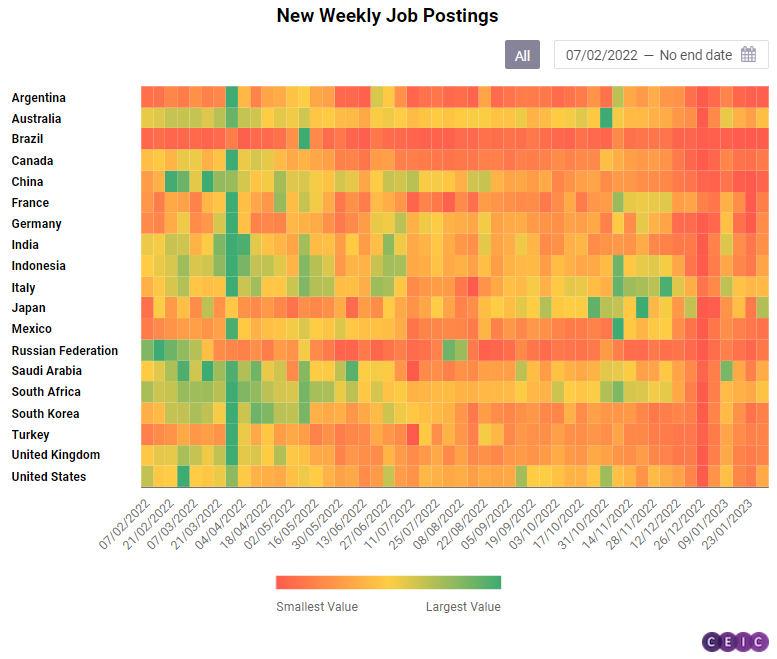
In that sense, online job postings' weekly data, sourced by Revelio Labs, can provide early signs of the labour market's performance of a given country, as well as of the overall economy. Further, it can provide valuable information to job seekers, employers, and policymakers in making informed decisions related to hiring, training, and workforce development. Weekly new online job postings data, capture important labour market trends in December 2022 and January 2023 ahead of the official data. According to the latest data, there has been a global stagnation in most major labour markets at the end of 2022 and the beginning of 2023. January saw a consistent decline in new job postings across almost all sectors for both developed and emerging markets. Active and removed job postings data also show similar trends. Although this development is at odds with traditional labour market indicators which still show high employment figures and low unemployment rates, it is in line with forecasts for the global economic slowdown in 2023.
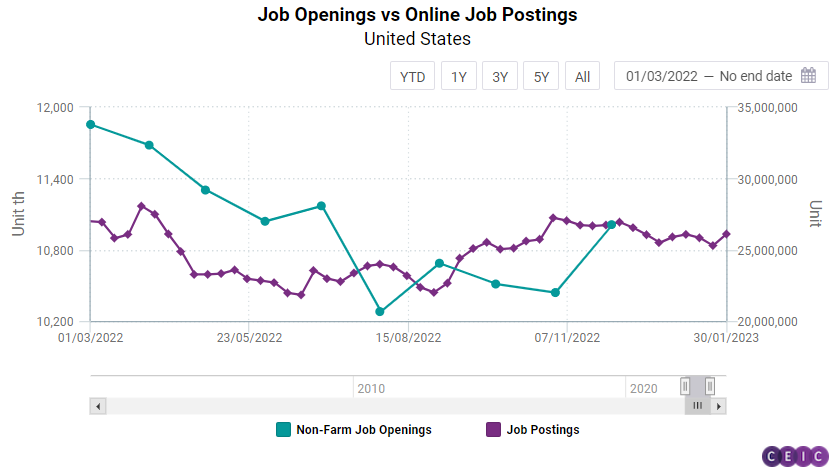
Advanced economies have shown a larger decline in new job postings in January 2023 compared to emerging markets. In the United States, the country with the largest online job posting market, new job postings dropped to 1.1mn in the week ending January 23, down 50.3% from the 2.6mn at the start of the month and the lowest since the start of the recorded period in the first week of February 2022. Active job postings fell by 19.3% for the same period, while removed job postings declined by 50.1%. A decline in new job advertisements was observed among all major US sectors, such as healthcare and social assistance, the administrative sector, retail, professional, scientific and technical services and information. Nevertheless, according to the US Bureau of Labor Statistics, the US labour market has remained tight as of December 2022, with an unemployment rate of 3.5% and the highest on record nonfarm payroll employment at 159.2mn, seasonally adjusted.
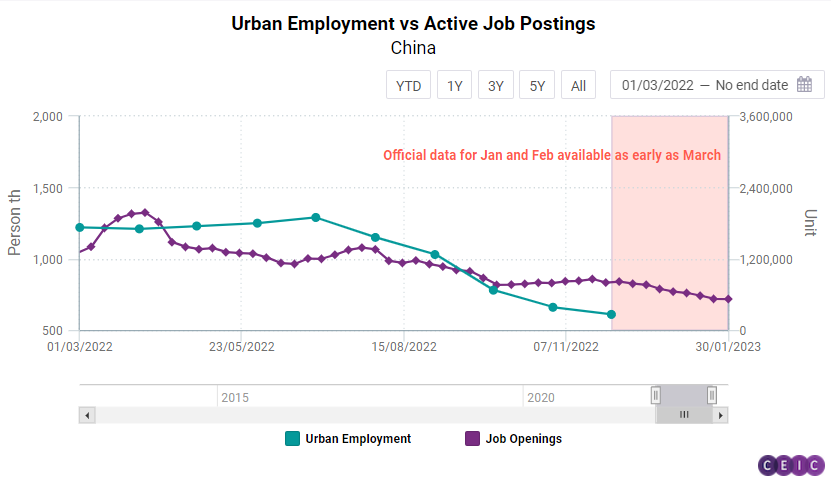
Data for the emerging markets also reveals significant drops in new postings since the start of January. New job postings in China fell to 4,414 in the week ending January 23, although this low figure can be explained by the festivities during the Chinese New Year. Nevertheless, new job offers have been dropping steadily since August 2022, across all sectors. According to official government data, the unemployment rate is at 5.5% as of December 2022. New job postings in India dropped to a record low of 47,844 in the week ending January 23, falling 37.3% in the space of two weeks. The drop can be traced to the professional, scientific and technical services sector which posts roughly a third of all online job advertisements for India. New job postings in Brazil also fell to a record low, decreasing by 28.1% w/w to 22,888, owing mainly to a drop in the information sector which accounts for the majority of online job postings.
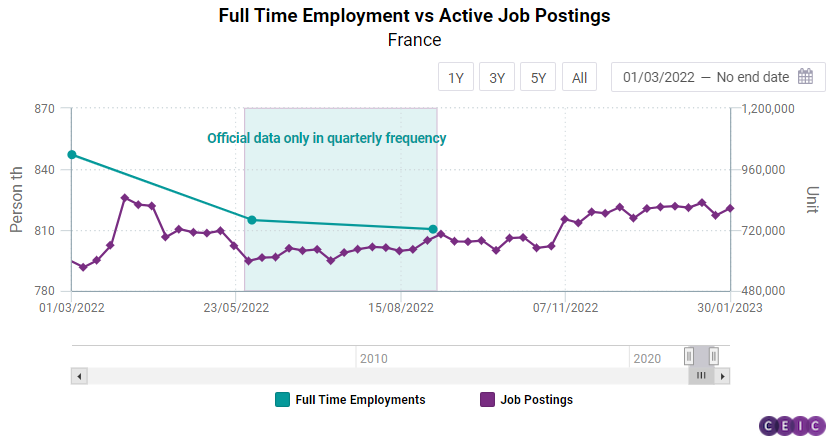
Online job postings data refers to the information about job openings advertised and posted on job boards, company websites, and social media. The economic importance of online job postings data lies in its ability to serve as a leading indicator of labor market conditions, as well as for the overall economy. Active job postings refer to the current job openings that are being actively advertised and accepting applications. These are positions that are available and an employer is looking to fill immediately. New job postings, on the other hand, refer to the newly added job openings that have just been posted by the employer. These new postings may or may not be immediately available for hire, and maybe in the process of being filled, or may become active job postings in the future. A decrease in the number of removed job postings may indicate a tight labor market, where employers have a hard time filling positions, while an increase in the number of removed job postings may indicate a slack in the labor market, where employers have less difficulty filling positions.
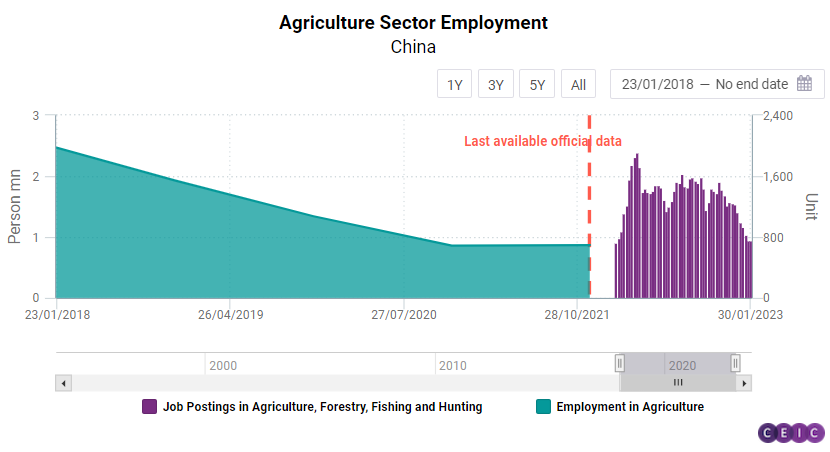
Online job postings data can be even more beneficial for emerging markets. Due to the Chinese holiday period in January and February, data for both of these months is released as early as March. In addition to this, the Chinese National Bureau of Statistics updates employment data per industry only once per year while alternative data provided by CEIC allows for weekly sectoral coverage.
Another challenge is emerging economies with large informal sectors, such as the case of India where credible high-frequency employment data from official sources is practically non-existent. Informal employment is often hidden from traditional employment data sources but can be captured through online job postings data.
The CEIC Global Database provides access to a vast database where users can gain insight into the ever-changing dynamics of world economies.
.png?width=160&name=ceic-logo-Vector%20logo%20no%20tagline%20(002).png)
